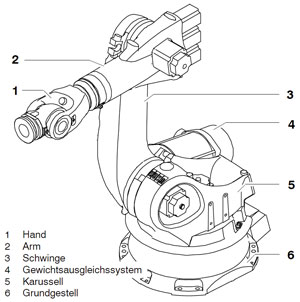
This was when the first PC-based controller developed by KUKA was launched. This launched the age of “true” mechatronics, characterized by the meticulous interplay of software, controller and mechanism. All that moves in automation comes from KUKA. Whether in logistics, the plastics or metal industries, medical technology or in the entertainment sector – KUKA robots are in use practically everywhere.
Robots are increasingly contributing to the optimization and flexibilization of vehicle production in the automobile industry. Here they mainly take on tasks such as welding, painting and bonding. If they are fitted with special dirt and heat-resistant foundry equipment, they can even work as an intelligent assistant in the manufacture of engines in the foundry. Over 1000 robots are active in the production of a car model in a car plant. So 4000 units are not unusual in a large plant. Robots score over their human colleagues with their economical production processes, reduced costs, higher output and constant quality. The more rotational and translation axes a robot has, the greater is its mobility. Current models with six axes are able to grip and handle almost any position in space. The robot is programmed by the controller. Its movements are executed by the interplay of the various axes. The tool required (e.g. a welding gun) can be mounted on the robot‘s hand at the end of the robot‘s arm. One drive on each axis is responsible for the movement of the axes. It consists of a motor, gearbox and controller.
KUKA series 2000 robots are used in the automotive industry for spot welding body panels, among other tasks. This process joins two thin metal panels together. A continuous weld is not required. An electric current concentrates high energies on a small area of a workpiece. High pressure then creates an unbreakable joint. The entire process takes only a fraction of a second, is easy to handle, requires no other materials such as gas or wire and can be automated without problem. However, the weld points must always be accessible from both sides. This is child‘s play for KUKA robots, as the welding gun almost becomes a seventh robot axis and so the movement of the gun and the robot are programmed and operated synchronously.
Almost all KUKA robots have six axes and therefore also the same number of transmissions, each of which are lubricated with 15 to 17 litres of synthetic gear oil. The oil is changed every five years or after 20,000 hours of operation. In the automotive industry, this operation is generally performed directly by the vehicle manufacturer‘s own service engineers. As the capacities of the transmissions are not very great, there is frequently no routine lubricant analysis for all transmissions. Yet the oil is subjected to high loads. The robots are in continuous use. Their movement is jerky and thus generates shocks in the transmission. The average temperatures in the transmissions is around 80°C. It is accordingly important that only lubricants recommended by KUKA are used. Only those gear oils that KUKA has previously thoroughly tested in practical tests supported by oil analyses are approved. Consistent performance by the lubricant ultimately contributes to reliability of production and the service life of the transmissions.
The screening of gear oils clearly illustrates the high priority oil analyses have in KUKA‘s quality assurance. The ambition is to replace the gear oils in the robots with lower friction lubricants changing from mineral oil-based gear oils to synthetic lubricants to achieve longer oil change intervals and to improve efficiency.
To this end, samples from more than 1000 robot transmissions were analysed by OELCHECK before it was possible to approve the synthetic gear oil for long-term use. – An impressive example of the great care that KUKA Roboter GmbH takes with its quality assurance.
related links
